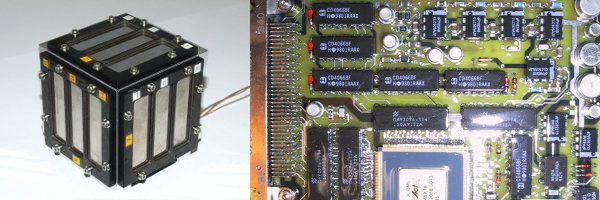
DIM – Dust Impact Monitor

The Dust Impact Monitor (DIM) on board the lander Philae measures the dust and ice particles escaping from the surface of the comet’s nucleus. These particles are detected when impacting on the surface of the cube-shaped DIM-sensor. DIM is one of three sub-instruments that constitute the instrument package SESAME on board Rosetta’s lander Philae.
Cometary nuclei mainly consist of frozen water and other volatile components as well as dust. When the volatile substances sublimate from the comet’s surface, dust and ice particles with a diameter between a few micrometers and decimeters are swept along and form the comet’s coma and tails. If the particles’ initial velocity is not large enough to enable them to leave the comet’s gravity field, they fall back to the surface.

The cube-shaped DIM-sensor located on the top side of Philae detects with piezoelectric plates the particles impacting from three different directions. In this way it is possible to measure both the particles returning to the surface under the influence of gravity and those ejected directly from the comet’s surface. The electrical signal created during elastic impact is then analyzed by the instrument’s electronic system with regard to its shape (amplitude and contact duration). The data obtained from this analysis is transmitted to Earth.
From these data, the number of impacting particles (particle flux), the rough distribution of their impact direction, and the development of these parameters in time can be determined. Assuming plausible particle densities, the mass and velocity of the particles can also be derived. This allows us to determine the particles’ initial velocity which in turn is correlated with the velocity, temperature, and flux of the gas emitted from the comet’s nucleus.
DIM has been developed and built at the Research Institute for Atomic Energy of the Hungarian Academy of Sciences (MTA) in Budapest. The DIM instrument on board Philae is operated by the German Space Agency (DLR) together with the MPS. The MPS is responsible for instrument calibration and for the scientific analysis of the data transmitted to Earth in close collaboration with all other scientists involved in the DIM project.

DIM specifications:
sensor area: 70 cm2
particle velocity: 0.25 - 2 m/s
particle radiusa: 0.2 - 5 mm
energy at impacta: 2 x 10-9 - 2 x 10-5 J
particle massa: 3 x 10-8 - 5 x 10-4 kg
a assuming spherical particles with a density of 1000 kg m-3 and an impact velocity of 0.3 m/s.
DIM-Team:
Harald Krüger
MPS, Göttingen
Principal Investigator (since 2009)
Alexander Loose
MPS, Göttingen
instrument engineer
Thomas Albin
MPS, Göttingen
student
Klaus J. Seidensticker, Hans-Herbert Fischer, Matthias Sperl
DLR, Köln/Berlin
Co-Investigators
Istvan Apáthy, Attila Hirn, Attila Péter
MTA-EK, Budapest, Hungary
Co-Investigators (I. Apáthy was Principal Investigator until 2008)
Alberto Flandes
UNAM, Mexico
Co-Investigator
Walter Arnold
University of Saarbrücken, Germany
University of Göttingen, Germany
Co-Investigator
Morris Podolak
University Tel Aviv, Israel
Co-Investigator
Masanori Kobayashi
Chiba Inst. of Technology, Japan
Associated Scientist
Ingrid Mann
EISCAT, Kiruna, Sweden
Associated Scientist
Antal Juhasz
Wigner RCP, Budapest, Hungary
Associated Scientist


